Here’s a citinerary after our visit in June…
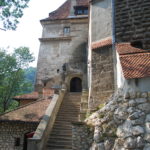 With a square section supported on three buttresses IT was built in 1622 during Gabriel Bethlen restoration works. The access stairs were built of wood on ITs Eastern side and in the 19th century they were replaced by the present stone staircase. Nowadays IT is the main access way to the castle.
With a square section supported on three buttresses IT was built in 1622 during Gabriel Bethlen restoration works. The access stairs were built of wood on ITs Eastern side and in the 19th century they were replaced by the present stone staircase. Nowadays IT is the main access way to the castle.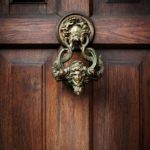 Nowadays IT is an imposing and quite steep staircase that leads to a beautiful oak door to the guards room. IT doesn’t have a defensive role anymore because in 18th century the canons became so powerful that castle walls were no longer indestructible. However, the Bran Castle was built in the 14th century, when bows and arrows were the deadliest weapons.
Nowadays IT is an imposing and quite steep staircase that leads to a beautiful oak door to the guards room. IT doesn’t have a defensive role anymore because in 18th century the canons became so powerful that castle walls were no longer indestructible. However, the Bran Castle was built in the 14th century, when bows and arrows were the deadliest weapons.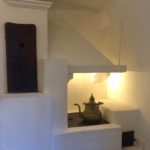 THIS VERY ROOM used to have a bread baking oven too, and after 1920, when a laundry room was installed, the window looking into the interior courtyard was decorated with a stone framing. Can you find the tea kettle?
THIS VERY ROOM used to have a bread baking oven too, and after 1920, when a laundry room was installed, the window looking into the interior courtyard was decorated with a stone framing. Can you find the tea kettle?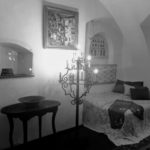 THIS is a vaulted room in the Southern tower. From 1938 to the end of 1947 THIS ROOM belonged to Princess Ileana.
THIS is a vaulted room in the Southern tower. From 1938 to the end of 1947 THIS ROOM belonged to Princess Ileana.
The museum pieces of THIS ROOM combine objects in the neo-Brâncovenesc style, Art Nouveau, Oriental Art, sacred pieces, Romanian folk art.
Can you find the wash basin with Oriental decorations?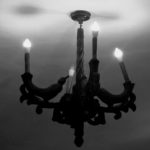 In the inter-war period, THIS ROOM was arranged to serve as a dressing room for Queen Marie. The furniture was of carved pinewood as were the two doors that are still preserved.
In the inter-war period, THIS ROOM was arranged to serve as a dressing room for Queen Marie. The furniture was of carved pinewood as were the two doors that are still preserved.
Can you find the bird carvings in the furniture of this room?
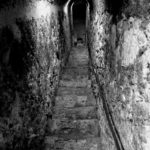 IT used to connect first floor of the castle to the third floor. IT was an escape tunnel built inside the wall and was used by the castle officers in case of emergency. IT was totally forgotten until 1920 when Queen Marie renovated the castle and an old fireplace was removed to rearrange the room. The throwing openings on the 4th floor were reached by mobile ladders in the Middle Ages.
IT used to connect first floor of the castle to the third floor. IT was an escape tunnel built inside the wall and was used by the castle officers in case of emergency. IT was totally forgotten until 1920 when Queen Marie renovated the castle and an old fireplace was removed to rearrange the room. The throwing openings on the 4th floor were reached by mobile ladders in the Middle Ages.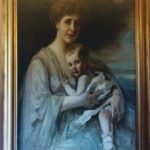 From the secret passage you’ll enter the most spacious room of the castle. HERE the queen and George Enescu, a close friend of the royal house used to organize concerts and receptions during the interwar period. Can you find the Loggia, an open room which served as a summer kitchen?
From the secret passage you’ll enter the most spacious room of the castle. HERE the queen and George Enescu, a close friend of the royal house used to organize concerts and receptions during the interwar period. Can you find the Loggia, an open room which served as a summer kitchen?
Can you find the photograph “Princess Ileana in 1928”?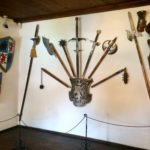 THESE TWO ROOMS contain shields and flags decorated with coats of arms from Transylvania and Walachia, medieval armors and weapons used to defend the city (halberds, swords, axes, flails, a mace, crossbow…)
THESE TWO ROOMS contain shields and flags decorated with coats of arms from Transylvania and Walachia, medieval armors and weapons used to defend the city (halberds, swords, axes, flails, a mace, crossbow…)
Can you find the coat of arms of Brașov?
What symbol is on it?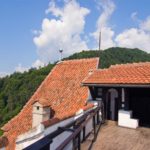 IT was built in the old attic of the fortress during the restoration works in the interwar period. To the South you can see the old Customs House, the old commercial road with defense wall and the electric plant installed in 1932, and to the North the wooden observation tower on the top of the donjon from where the sentinels were watching the area between Bucegi and Piatra Craiului Mountains.
IT was built in the old attic of the fortress during the restoration works in the interwar period. To the South you can see the old Customs House, the old commercial road with defense wall and the electric plant installed in 1932, and to the North the wooden observation tower on the top of the donjon from where the sentinels were watching the area between Bucegi and Piatra Craiului Mountains.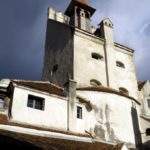 Located in the Northern part of the castle IT is the highest tower of the Bran defensive system. The single slope roof inclined towards the courtyard was useful as a measure of preventing fire being thrown inside the fortress. ITs upper part has a wooden balcony from where the sentinels were watching the surrounding area and signaling the enemies.
Located in the Northern part of the castle IT is the highest tower of the Bran defensive system. The single slope roof inclined towards the courtyard was useful as a measure of preventing fire being thrown inside the fortress. ITs upper part has a wooden balcony from where the sentinels were watching the surrounding area and signaling the enemies.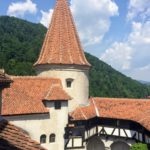 IT is located on the Western side, and once had a windowless prison with a low entranceway in ITs basement. The guards’ living quarters were on its ground floor.
IT is located on the Western side, and once had a windowless prison with a low entranceway in ITs basement. The guards’ living quarters were on its ground floor.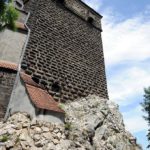 Located in the Eastern side of the castle, rectangular in section and covered with stone, IT has 2 machicolations, openings in the wall through which stones, wood stumps, boiling water or hot tar could be dropped on attackers at the base of the defensive walls. Inside IT there is a secret stone staircase cut into the wall providing access from the first to the third floors of the castle and to the fourth by a mobile ladder.
Located in the Eastern side of the castle, rectangular in section and covered with stone, IT has 2 machicolations, openings in the wall through which stones, wood stumps, boiling water or hot tar could be dropped on attackers at the base of the defensive walls. Inside IT there is a secret stone staircase cut into the wall providing access from the first to the third floors of the castle and to the fourth by a mobile ladder.
ANSWERS
- The Gate Tower
- The Entrance
- The Kitchen
- Queen Marie’s Bedroom
- Crossing Room
- Secret staircase
- Music Hall and Library
- The Weapons Rooms
- The Terrace
- The Donjon
- The Round Tower
- The Stone Tower
Did you know that Bran is a Turkish name meaning “gate”?
According to 16th century travelers to Bran access into the citadel was through an opening in the wall, probably on the Southern side, by means of a mobile ladder.
Did you know that a cable railway was used to transport the food the Queen used to share with her guests in the traditional five-o’clock tea gathering from the castle’s kitchen?
The castle was only inhabited by some members of the royal family, for whom separate apartments were arranged. Among them was Queen Marie, whose apartment included a hallway, a dressing room, two parlours, a bedroom, a bathroom and a dining room, as well as apartment where the sovereign gathered a variety of personal items (tableware, icons, statues, paintings, and books).
The Dutch cabinet and wooden chandelier have bird carvings!
The secret passage it’s no longer secret.
3rd floor
Brașov’s coat of arms is a crown with oak roots. The German name Kronstadt means “Crown City” and is reflected in the city’s coat of arms as well as in its Medieval Latin name, Corona. The two names of the city, Kronstadt and Corona, were used simultaneously in the Middle Ages, along with the Medieval Latin Brassovia.
4th Floor
The castle underwent reconstruction during the reign of Gabriel Bethlen (1613 – 1629), when the gate’s tower, the round tower and the donjon were all renovated.
REFERENCES
- Bran Castle – History
- Bran Castle – 5 facts that most tourists don’t know
- BRAN CASTLE, A QUEEN’S SANCTUARY
- Bran Castle Lego Model
- HISTORIC HOUSES: IN THE SHADOW OF DRACULA
- Lejean Travels – Bran
- Postcards from Bran Castle
- ROMGUIDE: BRAN CASTLE (DRACULA’S CASTLE)
- THE FASCINATING HISTORY OF BRAN: A VIRTUAL TOUR OF DRACULA’S CASTLE
